Impact mark on Jupiter, 19th July 2009
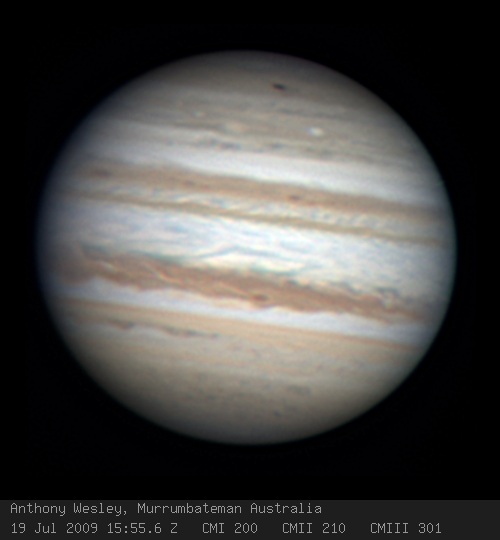
Image captured by Anthony Wesley on 19th July 2009 at 1554UTC from Murrumbateman Australia
I've been slashdotted, and my web server crushed. Now moved this to jupiter.samba.org provided by Tridge - thanks mate, you saved my a$$, you're a legend.
Preliminary image showing a black mark in Jupiters South Polar Region (SPR) which is almost certainly the result of a large impact - either an asteroid or comet - similar to the Shoemaker-Ley impacts in 1994.
Note to Media Images from this page may be used for editorial use only in news stories and publications provided correct attribution is retained.
Date and Time of Report
Dark impact mark first noted at approximately 1330UTC on 19th July 2009 from my home observatory just outside Murrumbateman NSW Australia.
Inspection of earlier images shows the impact visible on the planets limb at 1401UTC.
Equipment and Contact Details
Contact info: Anthony Wesley awesley@smartnetworks.com.au awesley@acquerra.com.au http://www.acquerra.com.au/astro Picture of Anthony and his 14.5 inch scope Scope: Homebrew GEM mounted Newtonian using a 14.5" Royce conical mirror (link to images removed until the slashdot tsumani retreats) Mount: Losmandy Titan Optics: - 14.5" f/5 Royce conical primary - 1/30 wave Antares Optics secondary - Televue 5x powermate , working at 7.7x Camera: Point Grey Research Dragonfly2 mono camera, ICX424al Filters: Astrodon I-Series RGB Capture details: 60 seconds in each filter @ 47fps. Capture software: Coriander Operating System: Linux (Fedora 10 x86) Processing software: Ninox for crop and presort Registax for alignment and stacking Astra Image for deconvolution and RGB align The Gimp for cleanup and captioning.
Observation Report
Update (20th July 1100UT) Glenn Orton from JPL has imaged this site using the NASA Infrared Telescope on Hawaii and confirms that it is an impact site and not a localised weather event.
I started this imaging session on Jupiter at approximately 11pm local time (1300UTC). The weather prediction was not promising, clear skies but a strong jetstream overhead according to the Bureau of Met. The temperature was also unusually high for this time of year (winter), also a bad sign.
The scope in use was my new 14.5" newtonian, in use now for a few weeks and so far returning excellent images.
I was pleasantly surprised to find reasonable imaging conditions and so I decided to continue recording data until maybe 1am local time. By about midnight (12:10 am) the seeing had deteriorated and I was ready to quit. Indeed I had hovered the mouse over the exit button on my capture application (Coriander for Linux) and then changed my mind and decided instead to simply take a break for 30 minutes and then check back to see if the conditions had improved. It was a very near thing.
When I came back to the scope at about 12:40am I noticed a dark spot rotating into view in Jupiters south polar region started to get curious. When first seen close to the limb (and in poor conditions) it was only a vaguely dark spot, I thouht likely to be just a normal dark polar storm. However as it rotated further into view, and the conditions improved I suddenly realised that it wasn't just dark, it was black in all channels, meaning it was truly a black spot.
My next thought was that it must be either a dark moon (like Callisto) or a moon shadow, but it was in the wrong place and the wrong size. Also I'd noticed it was moving too slow to be a moon or shadow. As far as I could see it was rotating in sync with a nearby white oval storm that I was very familiar with - this could only mean that the back feature was at the cloud level and not a projected shadow from a moon. I started to get excited.
It took another 15 minutes to really believe that I was seeing something new - I'd imaged that exact region only 2 days earlier and checking back to that image showed no sign of any anomalous black spot.
Now I was caught between a rock and a hard place - I wanted to keep imaging but also I was aware of the importance of alerting others to this possible new event. Could it actually be an impact mark on Jupiter? I had no real idea, and the odds on that happening were so small as to be laughable, but I was really struggling to see any other possibility given the location of the mark. If it really was an impact mark then I had to start telling people, and quickly. In the end I imaged for another 30 minutes only because the conditions were slowly improving and each capture was giving a slightly better image than the last.
Eventually I stopped imaging and went up to the house to start emailing people, with this image above processed as quick and dirty as possible just to have something to show.
More images will come along from me and many other people in the next few days.
*NOTE* Priority is being given to processing and uploading images as fast as possible, so the image quality is no necessarily as good as it might be. When time permits these images will be replaced by higher quality versions. Anthony
More Images:
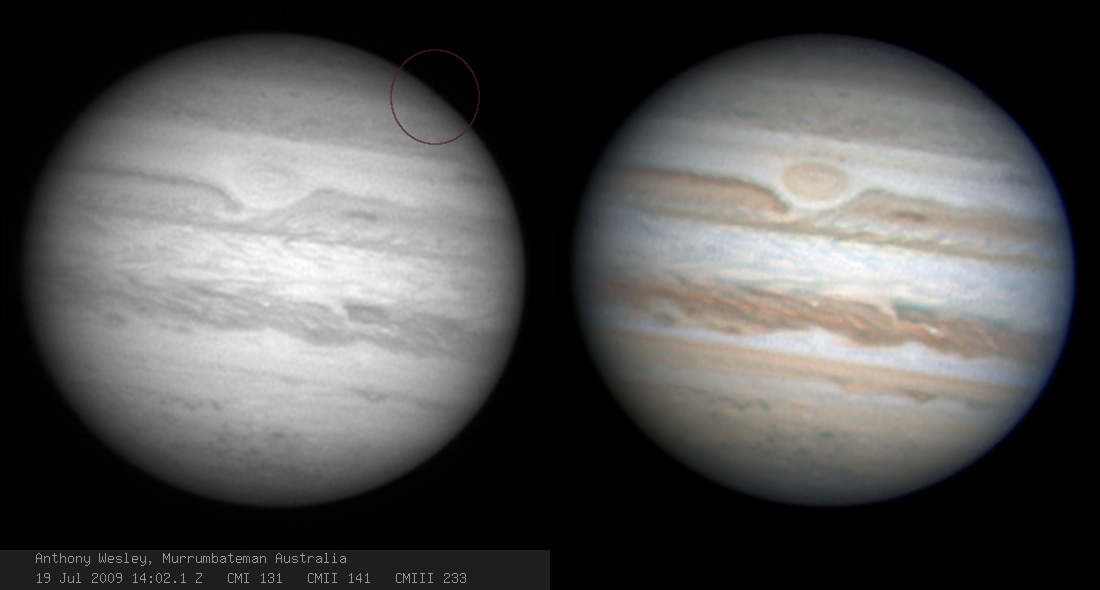
This is a very early image showing the impact mark (top right, on the limb). This image is red channel data only.
It is possible that this is the earliest recorded image of the event.
p.s. The GRS looks nice too, this was my real target for imaging this night!
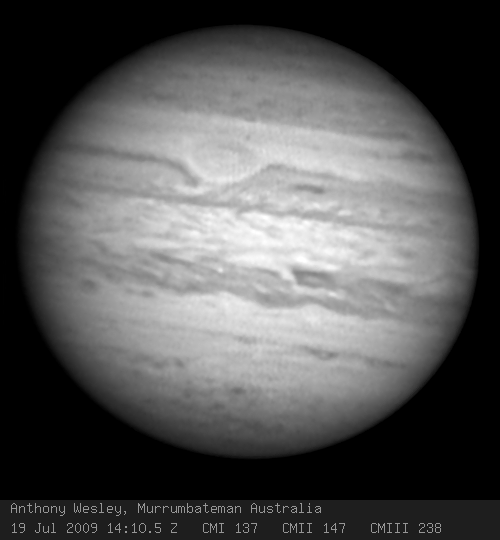
Another very early image of the dark spot, red channel data only. It's just visible on the limb to the upper right. Of course, it wasn't visible to me at the time I was recording the data, and after this sequence was captured I took a 30 minute break away from the scope... When I came back I noticed the dark spot.
Note the time on this image was incorrectly labelled as 141134UTC, this has been corrected
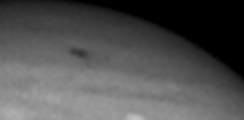
Closeup of this region in green light only, from reprocessed data (155537UTC). 3 small dark spots can be seen.
Update: Two of these three small spots may be pre-existing small storms. Thanks to a blink comparison by Brett Hughes.
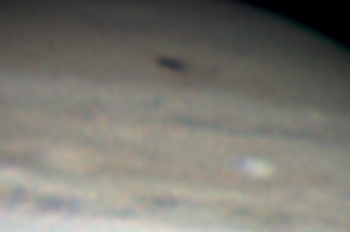
Same closeup as previous (155537UTC) , now in colour. 3 small dark spots can be seen in addition to the main one, possibly more. Still looking for better quality raw data from other imaging runs around this time.
Update: Two of these three small spots may be pre-existing small storms. Thanks to a blink comparison by Brett Hughes.
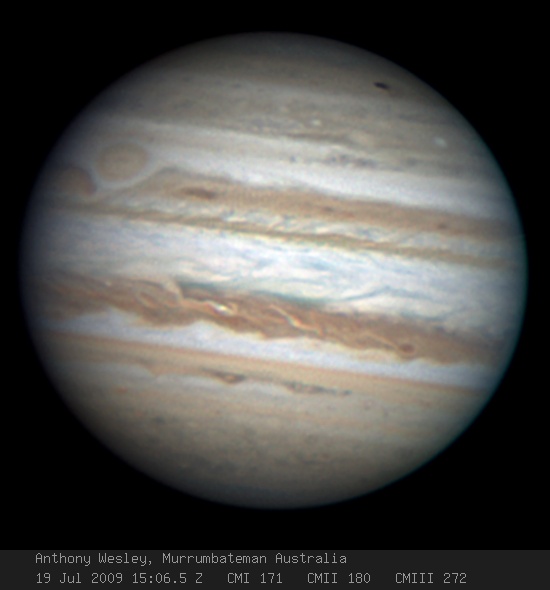
Earlier image showing the impact zone in slightly better seeing, but unfortunately the site itself is not as well resolved due to the viewing angle.

A later image in reasonable seeing.
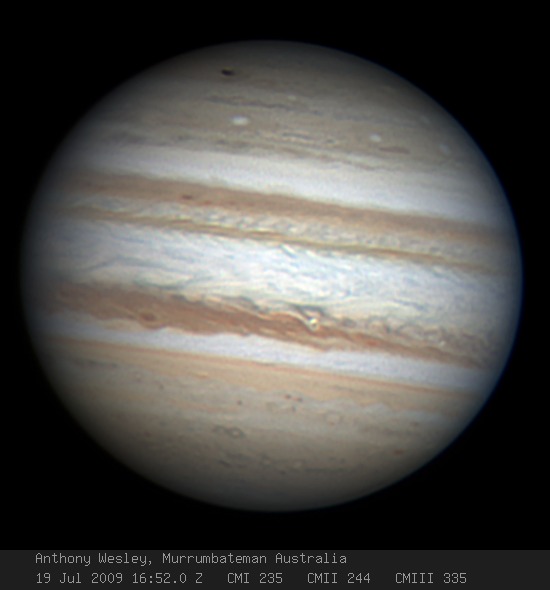
One of the last images from this session, this image has been more carefully processed to avoid artifacts by using 3x upsampling on the data before alignment and stacking.
23rd July 2009
Here are images from other amateurs from the first pass of this impact mark, on the same night as my images above. Please note that all images in this section are copyright to their respective owners and not for commercial use without their explicit explicit permission.
July 24 image

Here's an image in good seeing taken from my observatory on July 24, the impact region has started to spread noticeably.
Also see the Hubble Image taken shortly before this.
| |||
Mystery impact leaves Earth-size mark on Jupiter
(CNN) -- Jupiter is sporting a new scar after an unseen object hit the gaseous planet this week, NASA scientists say. An amateur astronomer in Australia noticed the new mark -- seen through telescopes as a dark spot -- on the planet early Monday and tipped off scientists at NASA's Jet Propulsion Laboratory (JPL) in Pasadena, California, who then confirmed it was the result of a new impact, NASA said. It's not clear what the object was that crashed into Jupiter's poisonous atmosphere. Glenn Orton, a JPL scientist, told the magazine New Scientist that it could have been a block of ice from somewhere in Jupiter's neighborhood, or a wandering comet that was too faint for astronomers to have detected before impact. The object created a mark on Jupiter that has the about same diameter as Earth, though the object itself was probably only 50 to 100 miles across, said Anthony Wesley, the amateur astronomer who first noticed the scar. The mystery object was likely moving at speeds of about 50 to 100 kilometers (31 to 62 miles) per second when it struck near Jupiter's south pole, Wesley told CNN. "That generates an unbelievable amount of energy when it collides with pretty much anything, but especially with something the size of Jupiter," he said. It is only the second time scientists have been able to observe the results of such an impact on Jupiter. The first happened 15 years ago, when comet Shoemaker-Levy 9 broke into 21 pieces and hit the planet's atmosphere. "Given the rarity of these events, it's extremely exciting to be involved in these observations," JPL astronomer Leigh Fletcher said in a NASA interview. Thermal images taken by NASA show the scar as a bright spot, which means the crash warmed the lower atmosphere in that area, New Scientist said. Researchers also found hints of higher-than-normal amounts of ammonia in the upper atmosphere. The Shoemaker-Levy comet also churned up extra ammonia, the magazine said. Jupiter's new spot isn't likely to last long -- probably just one to two weeks, Wesley said. He pointed out the impact scars from the Shoemaker-Levy debris lasted only two to three weeks before disappearing. Seeing an Earth-sized spot appear so tiny on Jupiter's surface led to some to wonder Tuesday whether our planet might be in danger of a similar collision. But Wesley said that shouldn't be a concern because Jupiter functions almost like a celestial vacuum cleaner, sucking up any objects that would be of danger to Earth and its neighbors. "Jupiter is doing a very good job in scooping up a lot of this material that's still floating around in the solar system," he said. "It's just got so much gravity as it swings around the outer part of the solar system, it can really pull in and swallow up many of the cometary objects and debris left over from the formation of the solar system. "So it's doing a good job in keeping us safe by cleaning out a lot of these bits and pieces." Jupiter is the fifth planet from the sun and the largest in our solar system. Its colorful atmosphere is 86 percent hydrogen and 14 percent helium, with tiny amounts of methane, ammonia, phosphine, water, acetylene, ethane, germanium, and carbon monoxide. The chemicals are responsible for producing the different colors of Jupiter's clouds. The temperature at the top of those clouds is about 230 degrees below zero Fahrenheit (145 degrees below zero Celsius), but it is far hotter near the planet's center. The core temperature may be about 43,000 degrees Fahrenheit (24,000 degrees Celsius), hotter than the surface of the sun. The most outstanding feature on Jupiter's surface is the Great Red Spot, a storm of gas that swirls at a speed of about 225 miles (360 kilometers) per hour at its edge. The spot -- which has been shrinking -- has a diameter equal to about three times that of Earth. |
| Find this article at: http://www.cnn.com/2009/TECH/space/07/21/jupiter.nasa.meteor.scar |
|





No comments:
Post a Comment